UPHOLSTERING METHODS
Copyright By The Goodheart-Willcox Company, Inc. (book no longer in print)
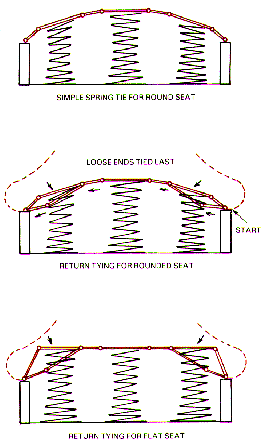
Coil springs are tied down firmly across their tops to prevent them from slipping sideways out of position. They should be tied to uniform height so that each spring's upward expansion is controlled. Before tying, springs usually stand about 1 1/2 in. (3.5cm) above the "normal" height. Firm springs are often tied at freestanding height (1 1/2 in. above normal height). Medium springs are generally tied 1 in. (2.5cm) below normal height and soft springs 2 in. below normal height.
Springs lose resiliency when compressed by tying. Extra height above the frame increases the resiliency of the springs. In seats, tops of springs, after tying, should be a minimum 3 in. (7.5cm) above the frame. This permits them to be depressed without taking up all slack in the spring twine.
Seat springs may be tied to form round or flat tops according to need or preference. Single sets of springs used without cushions are usually tied with a round contour for appearance and comfort. Flat-shaped tops are used particularly when two sets of springs or a removable cushion is used. For flat seats, return tie is fastened to the third coil from the top.

Round Seats.
The two-way (four knot) tie is often used to fasten round seats. Each row of springs is tied lengthwise and then crosswise. Each row uses a separate piece of spring twine. To estimate twine length, measure the distance across the frame lengthwise and crosswise. Double each measurement and allow 12 in. (30cm) extra length for knots. With scissors, cut enough pieces of spring twine for each row of springs.
Using an upholsterer's hammer, drive two No. 12 tacks into the frame opposite the center of each row of springs at either end. Space the tacks 1/2 in (12mm) apart and drive them only halfway into the frame.
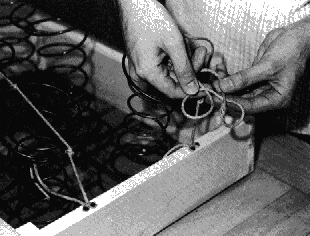
Form a clove hitch knot at one end of spring twine piece. Loop the knot around two of the partially driven tacks. Then drive the tacks tightly into the frame against the knot.

How to make three types of knots used in tying twine to springs. A- Steps for making clove spring knot. B- Procedure for overhand knot. C- Making the simple loop.
Depress the edge of the first spring (nearest double tack) to the desired height for a round seat. Pull the spring twine tightly around its top coil and make a clove spring knot or an overhand knot.
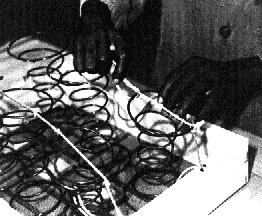
Then pull the twine taut to the opposite side of the spring and tie another knot. Tie all the springs in the same way.
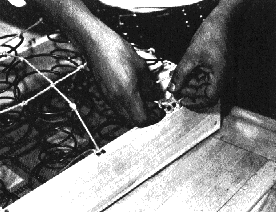
Fastening springs crosswise. Drive two No. 12 tacks into the frame opposite the center of each row of springs at each side. Then fasten the twine crosswise in the same way as lengthwise. Shape and tie the springs crosswise by the same method as was used lengthwise.
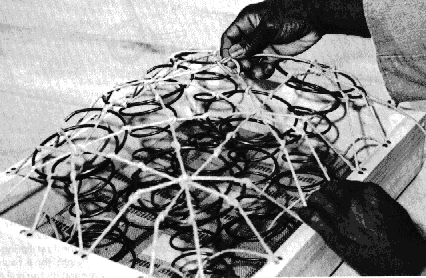
The four-way (eight knot) tie is sometimes used as extra support to hold coil springs. This method employs diagonal spring twines in the same way that lengthwise and crosswise twine pieces are used in the two-way (four knot) tie method. Clove hitch or overhand knots are tied around each spring and intersecting twine.
Springs for flat seat with return twine.
The two-way (four knot) tie is generally used to fasten flat seats. The procedure is similar to tying round seats.
Measure the distance across the frame lengthwise and crosswise. Double each measurement and allow 24 in. (61cm) extra length for knots and return twines. With scissors, cut the pieces of spring twine needed.
Fasten springs lengthwise. Using an upholsterer's hammer, drive two No. 12 tacks partway into the frame opposite center of each row of springs at both ends. This is the same procedure used with the round seat. Leave about 6 in. (15cm) of loose end on each piece of twine for tie back. Form a clove hitch knot, loop it around two of the partially driven tacks. Then drive the tacks tightly against the knot.
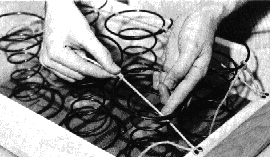
Wrap long end of the twine around the opposite side of the spring. Then compress the spring to the height you want and form a clove hitch knot.
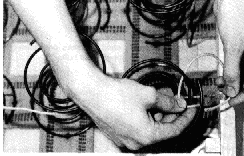
Fasten the loose (short) end of the twine to the first side of the spring (one nearest double tack). Attach it to the second spiral from the top. Use a clove hitch or overhand knot.
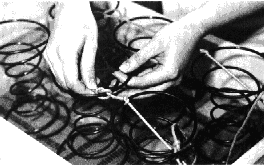
Pull the twine taunt to the next spring and wrap the twine around its nearest edge. Then compress the spring to the desired height and form a clove hitch or overhand knot. Continue tying the other springs in the same way. Fasten springs crosswise using the same method.
See the hand tools pro upholsterers use. Or buy at our upholstery tool kits page.
Supplement your professional tools with these items which you may already have or can get at a hardware store: wire cutters for pulling out staples (an old dull pair is good because it won't cut the staples), a framer's square for getting straight cuts on fabric, a 45" or 60" ruler (most upholstery weight fabric is US is 54" wide) and a utility knife for stripping off old fabric.
This video can help you decide whether to buy air or electric, 3/8 or 1/2" crown.
Buy air guns here: UPHOLSTERY STAPLER
Buy electric guns here: PRO ELECTRIC UPHOLSTERY STAPLER Electric guns from hardware stores shoot too thick of a staple and aren't powerful enough for furniture hardwoods.
